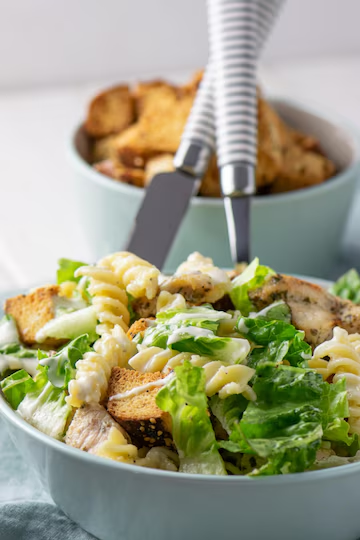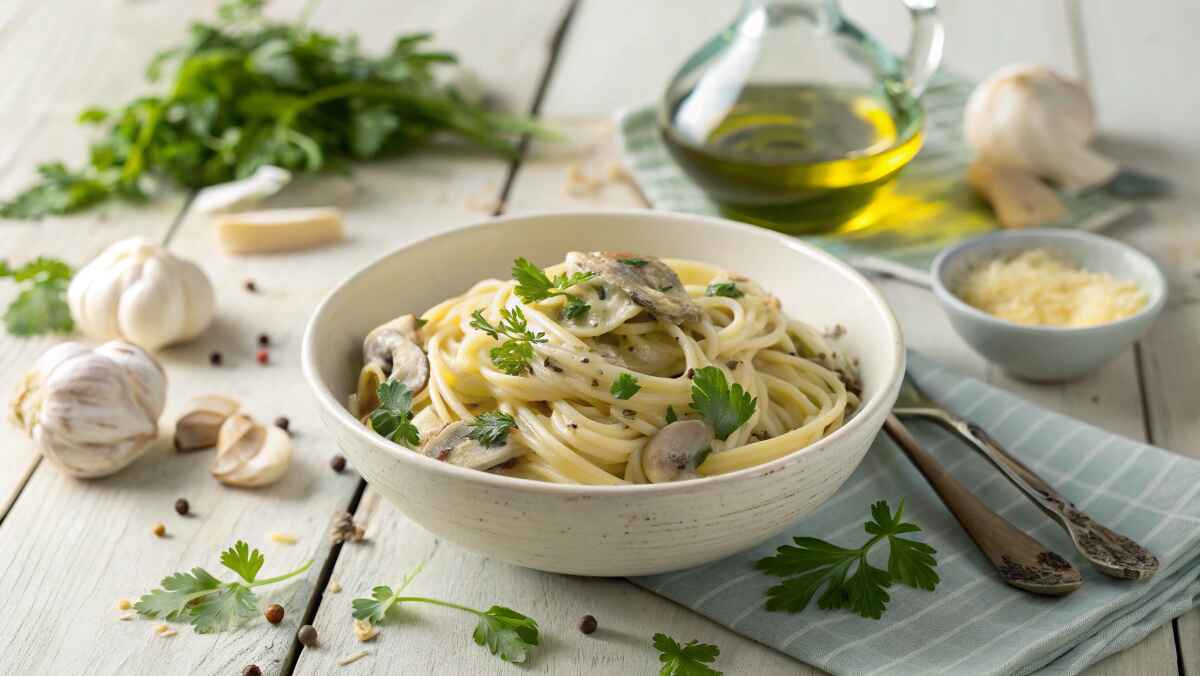Caesar salad with chicken is a beloved dish known for its creamy dressing, crisp greens, and satisfying protein. Whether served as a light lunch, a hearty dinner, or a side dish, it remains a staple on menus worldwide. But while it’s undeniably delicious, is Caesar salad with chicken good for you?
The answer depends on how it’s prepared. While the lean protein from chicken and the vitamins from Romaine lettuce offer health benefits, traditional Caesar dressing, croutons, and cheese can make this dish high in calories, fat, and sodium. Fortunately, with a few mindful adjustments, you can enjoy Caesar salad without compromising on health.
In this guide, we’ll break down the nutritional profile of Caesar salad with chicken, explore its health benefits and potential drawbacks, and share expert tips on making a healthier version—so you can enjoy this classic dish guilt-free!
🥗 Healthy Caesar Salad with Chicken & Parmesan Recipe
This lightened-up Caesar salad with chicken delivers all the classic flavors you love while keeping it nutrient-dense and balanced. Using grilled chicken, a lighter homemade dressing, and finely grated Parmesan, this recipe provides plenty of protein, fiber, and essential vitamins—without excessive calories or sodium.
🍽️ Servings: 2 | ⏳ Prep Time: 15 mins | 🔥 Cook Time: 10 mins
🛒 Ingredients
For the Salad:
✅ 4 cups Romaine lettuce, chopped
✅ 1 medium chicken breast, grilled and sliced
✅ ¼ cup Parmesan cheese, finely grated
✅ ½ cup cherry tomatoes, halved (optional)
✅ ¼ cup homemade whole-grain croutons or roasted chickpeas
✅ 2 tbsp toasted sunflower seeds or sliced almonds (optional)
For the Lighter Caesar Dressing:
✅ ¼ cup Greek yogurt (or olive oil-based mayo)
✅ 2 tbsp extra virgin olive oil
✅ 2 tbsp lemon juice, freshly squeezed
✅ 1 tbsp Dijon mustard
✅ 1 tsp Worcestershire sauce
✅ 1 garlic clove, minced
✅ 2 tbsp grated Parmesan cheese
✅ ½ tsp black pepper
✅ ½ tsp sea salt
✅ 1–2 tsp water (to thin, if needed)
👨🍳 Instructions
1️⃣ Grill the Chicken
🔥 Season the chicken breast with a pinch of salt, pepper, and a drizzle of olive oil.
🔥 Grill over medium heat for 5–6 minutes per side until fully cooked.
🔥 Let it rest for 5 minutes, then slice into thin strips.
💡 Tip: Marinate the chicken in lemon juice and garlic for extra flavor!
2️⃣ Make the Lighter Caesar Dressing
🥄 In a small bowl, whisk together Greek yogurt, olive oil, lemon juice, Dijon mustard, Worcestershire sauce, and minced garlic.
🧀 Stir in grated Parmesan cheese, black pepper, and salt until smooth.
💦 If the dressing is too thick, add 1–2 tsp of water until desired consistency is reached.
💡 Tip: Let the dressing chill for 10 minutes to let the flavors develop!
3️⃣ Assemble the Salad
🥬 In a large bowl, toss the chopped Romaine lettuce with half of the dressing until evenly coated.
🍗 Top with grilled chicken slices, cherry tomatoes, croutons (or roasted chickpeas), and sunflower seeds.
🧀 Sprinkle finely grated Parmesan on top for maximum flavor.
4️⃣ Serve & Enjoy!
🥄 Drizzle with the remaining dressing and toss lightly.
🍋 Garnish with extra lemon juice or freshly cracked pepper for an added kick.
🔥 Serve immediately for maximum crunch and freshness!
💡 Healthier Swaps & Additions
✔️ Low-Carb Option → Skip croutons and use extra veggies or avocado.
✔️ Gluten-Free Option → Use gluten-free croutons or roasted chickpeas.
✔️ Extra Protein Boost → Add hard-boiled eggs or grilled shrimp.
✔️ Dairy-Free Version → Swap Parmesan for nutritional yeast.
🥗 Nutritional Info (Per Serving)
✅ Calories: ~380
✅ Protein: ~42g
✅ Carbs: ~18g
✅ Healthy Fats: ~18g
✅ Fiber: ~4g
🥗 The Nutritional Breakdown of Caesar Salad with Chicken
To understand whether Caesar salad with chicken is healthy, let’s take a closer look at its core ingredients and how they contribute to nutrition and overall wellness.
🥬 Romaine Lettuce: The Nutrient-Packed Base
Romaine lettuce is more than just a crunchy base—it’s a nutrient powerhouse with numerous health benefits:
✔️ Rich in Vitamins A, C, and K – Supports immune health, skin repair, and bone strength.
✔️ Low in Calories – Only about 8 calories per cup, making it great for low-calorie meals.
✔️ High in Antioxidants – Contains beta-carotene and lutein, which help reduce the risk of chronic diseases.
✔️ Hydrating & Refreshing – Composed of over 90% water, helping with hydration.
💡 Health Tip: Choose dark, crisp Romaine leaves for the most nutritional benefits!
🍗 Chicken: Lean Protein for Muscle Health
Adding grilled chicken turns a Caesar salad into a protein-rich, satisfying meal:
✔️ High in Protein – A 3-ounce serving of chicken breast provides 26 grams of protein with minimal fat.
✔️ Boosts Metabolism – Rich in B vitamins (B3 & B6), supporting energy production and brain function.
✔️ Keeps You Full Longer – Lean protein helps control hunger and promote muscle repair.
💡 Health Tip: Grilled or baked chicken is the healthiest choice—avoid fried or breaded versions to cut down on unhealthy fats.
🥄 Caesar Dressing: The Flavor Powerhouse (But Watch Out for Calories!)
Traditional Caesar dressing is rich and flavorful, but it’s also one of the most calorie-dense components of the salad:
✔️ Made with Olive Oil, Parmesan, Egg Yolk, and Anchovies – These ingredients provide a creamy texture but are high in fat and sodium.
✔️ High in Calories – A standard 2-tablespoon serving can contain 150–200 calories and up to 20g of fat.
✔️ Sodium Content – Many store-bought dressings contain high amounts of salt, contributing to water retention and high blood pressure.
💡 Health Tip: Opt for a Greek yogurt-based dressing or make your own at home with olive oil, lemon juice, Dijon mustard, and garlic for a lighter alternative.
🥖 Croutons: Crunchy but Often Empty Calories
Croutons add texture but can also increase carbs and calories without much nutritional value:
✔️ Made from Refined White Bread – Lacks fiber and essential nutrients.
✔️ Often High in Added Fats – Store-bought croutons are usually fried or baked with unhealthy oils.
✔️ Can Add Over 100 Extra Calories – Just a small handful can increase caloric intake significantly.
💡 Health Tip: Swap croutons for roasted chickpeas, toasted pumpkin seeds, or whole-grain homemade croutons for a healthier crunch!
🧀 Parmesan Cheese: A Tasty Boost with Calcium
Parmesan cheese is a key ingredient in Caesar salad, adding a rich, nutty flavor that enhances every bite. Beyond its taste, Parmesan is also a nutrient-dense cheese that provides essential vitamins and minerals, making it a valuable addition to a well-balanced diet. However, due to its high sodium and fat content, it’s best enjoyed in moderation to maintain a healthy balance.
🥛 A Nutritional Powerhouse: Why Parmesan Is Good for You
✔️ High in Calcium – Parmesan is one of the best natural sources of calcium, which plays a crucial role in bone health. A one-ounce serving provides about 336 mg of calcium, covering 30% of the daily recommended intake. Strong bones and teeth rely on sufficient calcium levels, making Parmesan a great addition to your diet—especially for those who may struggle to get enough calcium from other sources.
✔️ Rich in Protein – Protein is essential for muscle growth, repair, and overall body function. Just one tablespoon of Parmesan contains 2 grams of protein, making it a small but mighty way to increase your protein intake without adding excess calories.
✔️ Packed with Essential Nutrients – In addition to calcium and protein, Parmesan contains vitamins A, B12, and phosphorus, which support immune function, red blood cell production, and energy metabolism.
✔️ Easy to Digest – Unlike many other cheeses, aged Parmesan is naturally lower in lactose, making it easier to digest for those who are lactose intolerant.
✔️ Boosts Flavor Without Extra Calories – Parmesan has an intense, umami-rich taste, meaning a little goes a long way. Even a small amount can enhance the overall flavor of your salad without the need for extra seasoning or high-calorie dressings.
⚠️ Watch Out for Sodium & Fat
While Parmesan cheese offers many health benefits, it also has a high sodium content, which can contribute to high blood pressure if consumed in excess.
✔️ Sodium Content – A one-ounce serving of Parmesan contains about 450 mg of sodium, which is 20% of the recommended daily intake. Since Caesar dressing and croutons can also be high in sodium, it’s important to use Parmesan sparingly to keep salt levels in check.
✔️ Fat Content – Parmesan is naturally higher in fat than some other cheeses. While it contains healthy fats, too much can contribute to excess calorie intake, so portion control is key.
💡 Health Tip: Use a fine grater! Grating Parmesan finely helps spread the flavor more evenly throughout your salad, allowing you to use less without compromising on taste.
🧀 Smart Ways to Enjoy Parmesan in a Healthier Caesar Salad
✅ Use Less, But Maximize Flavor – Instead of large Parmesan shavings, opt for finely grated Parmesan. This way, you get the same delicious taste with fewer calories and sodium.
✅ Try Lower-Sodium Cheese Alternatives – If you’re watching your sodium intake, consider using a reduced-sodium Parmesan or swapping part of the cheese for a milder, lower-sodium option like Pecorino Romano or nutritional yeast.
✅ Pair It with Fresh Ingredients – Combining Parmesan with fresh herbs, lemon juice, and a lighter dressing can enhance the flavor of your Caesar salad without relying too much on cheese.
✅ Balance It with Other Nutrient-Rich Toppings – Instead of increasing the amount of cheese, add extra protein and fiber by incorporating grilled chicken, roasted chickpeas, or crunchy vegetables for a more well-rounded meal.
🥗 How to Make Caesar Salad with Chicken Healthier
Want to enjoy Caesar salad with chicken without excess calories? Try these simple swaps and modifications:
1️⃣ Lighten Up the Dressing
✔️ Use a Greek yogurt-based Caesar dressing instead of mayo-heavy versions.
✔️ Reduce the amount of dressing to control calorie intake.
✔️ Add extra lemon juice, Dijon mustard, or herbs for more flavor without extra fat.
2️⃣ Swap or Skip Croutons
✔️ Replace croutons with roasted chickpeas or sunflower seeds for extra fiber and protein.
✔️ Use homemade whole-grain croutons with olive oil for a healthier alternative.
✔️ Skip croutons entirely for a low-carb version.
3️⃣ Boost Nutrition with More Vegetables
✔️ Add cherry tomatoes, cucumbers, bell peppers, or roasted zucchini for extra fiber and vitamins.
✔️ Mix in kale or spinach for additional iron and antioxidants.
4️⃣ Choose Lean Proteins
✔️ Stick to grilled or roasted chicken instead of fried or breaded options.
✔️ Try other proteins like shrimp, tofu, or salmon for variety.
5️⃣ Watch Your Portion Size
✔️ Smaller portions as a side salad keep calories in check.
✔️ Pair with a healthy soup or whole-grain bread for a well-rounded meal.
❓ FAQs About Caesar Salad with Chicken
1️⃣ Is Caesar Salad with Chicken Good for Weight Loss?
✅ Yes—if made with grilled chicken, less dressing, and minimal croutons, it can be a high-protein, low-calorie meal.
2️⃣ What’s the Healthiest Dressing Option?
✅ Homemade dressings with Greek yogurt, olive oil, and lemon juice are the best for lower fat and fewer artificial ingredients.
3️⃣ Can I Make It Gluten-Free?
✅ Yes! Just skip the croutons or use gluten-free alternatives like roasted chickpeas.
4️⃣ Is Caesar Salad with Chicken Keto-Friendly?
✅ Yes—if you remove croutons and use a low-carb dressing.
5️⃣ How Can I Reduce Sodium in Caesar Salad?
✅ Use less Parmesan, a low-sodium dressing, and fresh garlic instead of anchovies.
🥗 Final Thoughts: Enjoying Caesar Salad with Chicken the Healthy Way
Caesar salad with chicken is more than just a classic, indulgent favorite—it can also be a nutritious, well-balanced meal when prepared mindfully. While the rich dressing, croutons, and cheese can add extra calories, simple modifications and ingredient swaps can turn it into a healthy, satisfying dish that fits into any lifestyle.
By making a few smart choices, you can maximize the nutritional value of your Caesar salad while keeping all the flavors and textures you love. Whether you’re looking for a high-protein meal, a lighter option, or a low-carb variation, there are endless ways to customize this dish to meet your dietary goals.
🥗 Smart Ways to Make Caesar Salad with Chicken Healthier
✅ Choose Lean Grilled Chicken – Skip the fried or breaded options to reduce unhealthy fats and keep the meal protein-rich and nourishing.
✅ Opt for a Lighter Dressing – Use a Greek yogurt-based Caesar dressing or make your own with olive oil, lemon juice, Dijon mustard, and garlic to cut down on excess fat and calories.
✅ Load Up on Veggies – Add cherry tomatoes, cucumbers, kale, spinach, or roasted bell peppers for extra fiber, vitamins, and antioxidants.
✅ Swap Croutons for Healthier Alternatives – Try roasted chickpeas, toasted nuts, or whole-grain croutons for added crunch without the empty calories.
✅ Control Portions – Enjoy the salad as a main course with lean protein, or serve a smaller portion alongside other nutrient-dense foods like whole-grain bread or a healthy soup.
💡 Why Caesar Salad with Chicken Can Be a Great Addition to Your Diet
When prepared with high-quality, fresh ingredients, Caesar salad with chicken can be a filling, nutrient-packed meal that offers:
✔️ A High-Protein Boost – Essential for muscle repair, satiety, and metabolism support.
✔️ Rich Vitamins & Minerals – From Romaine lettuce, fresh veggies, and Parmesan cheese.
✔️ Heart-Healthy Fats – When using olive oil-based dressings and healthy toppings.
✔️ Balanced Macros – With the right modifications, it provides a well-rounded mix of protein, fiber, and healthy fats.
🍽️ Enjoy Every Bite—Without the Guilt!
One of the best things about Caesar salad with chicken is its versatility. Whether you’re meal prepping for the week, serving it at a dinner party, or simply craving a fresh, satisfying meal, you can adjust the ingredients to suit your nutritional needs.
By making small but impactful changes, you don’t have to give up the flavors you love—instead, you’re creating a healthier, better-for-you version of this timeless favorite.
✨ So go ahead—grab your fresh ingredients, make those healthy swaps, and enjoy a guilt-free, flavorful Caesar salad with chicken today! 🥗💚🍗
Would you like recommendations for different protein options or a homemade Caesar dressing recipe to enhance your dish? Let me know! 😊🚀




